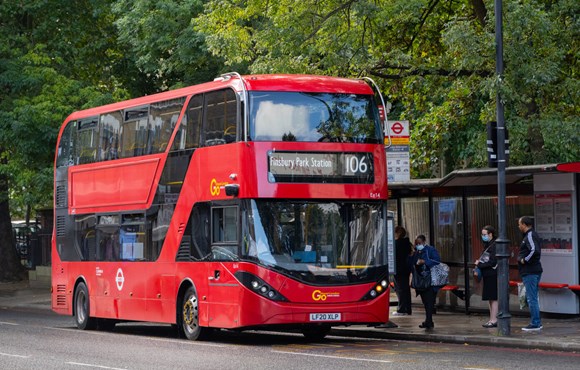
Thursday 7 Sep 2023
TfL sets out bold new strategy for making buses safer

PN-099
- A safe bus network is at the heart of the Mayor’s Vision Zero goal to eliminate death and serious injury on the transport network
- New strategy outlines specific actions for improving safety, including trialling innovative technology, launching a new Bus Safety Innovation Challenge and commissioning further research to reduce road danger risk
- Strategy will work towards the ambitious goal of ensuring no deaths are caused by bus collisions by 2030, or serious injuries caused by bus collisions by 2041
Transport for London (TfL) has published a new Bus Safety Strategy that outlines specific actions to be taken to achieve its Vision Zero goals for the bus network, which aim to reduce the number of deaths caused by bus collisions and for zero serious injuries by 2041. The aim of the strategy is to set out TfL’s safety priorities for the bus network and ensure that buses remain the safest way to travel on the roads.
TfL’s world-leading Bus Safety Programme is already delivering the greatest reduction in the number of people killed or seriously injured per journey of any road-based mode of transport. The Bus Safety Standard, which sets out the standards required for new buses in the capital’s fleet, is at the heart of this programme and is leading the international bus industry in requiring physical and technological safety improvements. TfL has now reached the milestone of more than 1,000 buses in London’s fleet meeting the standard.
The roadmap for the standard introduced safety measures in 2019 and 2021. This included: Intelligent Speed Assistance technology, which keeps bus speeds to the speed limit; Responsive Acoustic Vehicle Alerting Systems, to enable zero emission vehicles to make a sound that alerts other road users of their presence; and the urban bus sound, that helps to ensure all road users are aware of quiet running buses. Further improvements are due in 2024, such as requirements for Advanced Emergency Braking, further improvements to interiors to enhance passenger safety and vulnerable road user alerting systems.
The new Bus Safety Strategy sets out what TfL and bus operators are already doing and what more needs to do be done to meet the Vision Zero ambition in London. TfL recently launched the fourth Bus Safety Innovation Challenge to help find solutions to reduce injuries to customers while travelling on a bus. The challenge, which launched on 31 July, aims to identify and trial new ways of helping reduce injuries to customers travelling on buses - in particular incidents where the customer is injured while standing or moving on bus services or on stairs.
The actions set out in the strategy include commitments to:
- Go further and faster by retrofitting technology onto the existing fleet, including fitting a further 1800 buses with Intelligent Speed Assistance so that half of all buses are fitted with this safety technology by 2024, and the majority of the bus fleet by 2030
- Commission further research to identify the most effective measures to avoid and mitigate the risks posed by pedal application error
- Trial fatigue detection technologies on up to 450 buses over a 12 to 18 month period
- Implement a strategic data-led approach looking at what changes can be made across the network to reduce passenger injuries, particularly due to slips, trips and falls
- Work with the London Fire Brigade and other key stakeholders to identify vital new measures to tackle the risks posed by bus fires
- Ensure safety improvements are inclusive for all those who work and use the bus network
The strategy, which is available on the TfL website here, sets out the work currently being carried out by TfL, bus operators and the bus industry to deliver a safe bus network. Good progress has been made as the number of people killed in collisions involving London buses in 2022 reduced by 65 per cent against TfL's 2005-09 baseline, compared to an overall reduction across all transport modes on London’s roads of 52 per cent. The number of people seriously injured has reduced by 54 per cent, compared to an overall reduction across all transport modes on London’s roads of 38 per cent. However, this can’t be achieved by working alone and renewed focus and collaboration is required to further improve bus safety and reduce harm to those outside and on a bus.
Louise Cheeseman, TfL’s Director of Buses, said: “Safety is our first consideration in all that we do to deliver bus services in London and we’re determined that it will continue to be at the heart of our transport network. This new strategy is a vital part of our approach to systematically making transport safer for everyone. The measures outlined in this strategy will be vital to achieving our Vision Zero goal of ensuring nobody is killed or seriously injured on the transport network.”
The Bus Safety Programme was established in 2016 to address concerns about the safety of the bus network. Later, it was adapted to support the Vision Zero targets for buses set out in the Mayor’s Transport Strategy and Vision Zero action plan in 2018. The Bus Safety Programme is also one of the five priorities within TfL’s Bus Action Plan.
Contact Information
TfL Press Office
Transport for London
0343 222 4141
pressoffice@tfl.gov.uk
Notes to editors
Further information on TfL’s work on bus safety is available on the TfL website here



